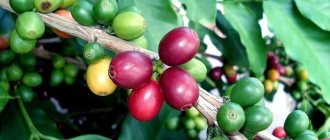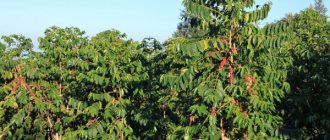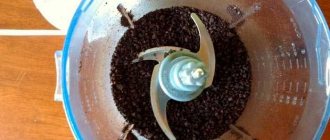It's no secret that coffee has an excellent stimulating effect. Just a few cups of this wonderful invigorating drink can relieve the feeling of fatigue and activate brain processes. The grains contain caffeine, fiber, various minerals and nitrogenous compounds, which well tone the central nervous system of our body.
The fruits of the plant have long been used in traditional medicine for medicinal purposes. Pharmacies now sell coffee charcoal, a drug that doctors recommend for poisoning to neutralize toxins in the gastrointestinal tract.
Many people have seen how coffee blooms in the photo. Probably every gardener, both beginner and experienced, dreams of a coffee tree as a house plant. There is an opinion that its cultivation requires a special, professional approach. In reality, the process is no more complicated than caring for common indoor plants. Using our tips, you can competently and without any problems grow an Arabica coffee flower on your own windowsill.
Care after purchase
So, how to grow Arabica coffee at home? The coffee tree is famous for its unpretentiousness, but this does not mean that it does not need care and the creation of the necessary conditions.
REFERENCE! The first thing you should think about before purchasing is whether your apartment has the space needed for the tree. The fact is that Arabica can grow to the size of a two-meter bush.
Position the plant so that the sun's rays do not directly hit the leaves. Contact with sunlight can cause burns on tender leaves. At the same time, Arabica loves bright lighting, preferably a little diffused.
If there is a lack of natural light, you can install phytolamps. This will create additional lighting. Coffee will feel most comfortable on windows facing east or west.
ATTENTION! Arabica is native to the tropical lands of Asia and Africa. It is there that this species grows wild. The climate in Russia is unsuitable for coffee, so attempts to create a plantation on your own estate will not achieve the expected result. Arabica will not survive the cold season.
Watering
The active period occurs in the warm part of the year, from approximately March to October. At this time, Arabica needs the soil to constantly maintain moisture and not dry out. During hibernation, water consumption decreases.
It is better to pre-settle water for irrigation or use filtered purified water.
REFERENCE! In an effort to maintain soil moisture, you cannot overdo it and create an artificial swamp. If you overdo it with moisture, there is a danger of rotting of the root system.
Feeding should be done during the active period. Fertilizer should be added to the water for irrigation once a week.
ATTENTION! The fertilizer should not contain calcium.
During the cold season, a period of rest begins. During this period, watering should be reduced. It should also be taken into account that in winter evaporation occurs with less intensity than in summer.
REFERENCE! In addition to watering, Arabica requires constant spraying. The humidity in the room is of great importance for the plant. It is especially important to spray leaves during the heating season, when the air in apartments becomes especially dry.
Bloom
Coffee blooms in a delicate white color. The thin petals of the Arabica coffee flower exude a rich, pleasant aroma. As a rule, the flowering of the Arabica coffee tree begins in the third or even fourth year of life.
Subsequently, the flowers give way to small round red fruits. If, upon reaching the specified period, flowers do not appear on the tree, then you need to check whether the plant is being cared for correctly.
ATTENTION! Proper lighting is important for the coffee tree to bloom. The reason for the lack of flowers may be a lack of light.
Below are photos of Arabica coffee; caring for it at home allows you to achieve the following results:
Priming
For Arabica, slightly acidic soil is most suitable. If it is not possible to purchase a ready-made soil mixture for a coffee tree, you can use mixtures for plants that also prefer acidic and slightly acidic soil. These plants include azalea or hydrangea.
REFERENCE! Before planting your coffee tree, make sure the pot you choose is the right size. A thick drainage layer should be placed on the bottom. This is a prerequisite for all plants that require abundant watering. If the drainage layer is sufficient, then water will not linger near the roots and will not create a risk of rotting.
Transfer
Young coffee trees need to be replanted annually.
The best time of year for transplantation is spring .
When the plant reaches a large size and stops growing, the need for regular replanting disappears.
It is enough to replace the top soil annually.
How to care for your Arabica coffee houseplant
The main thing that will help you grow a strong and healthy coffee tree, and in the morning enjoy the taste of a drink made from a homemade product, is creating optimally comfortable conditions for its development (sufficient light, water and proper fertilizing). If these factors are lacking, the coffee plant may simply die. Then your expectations and efforts will not be justified, and the time devoted to this activity will simply be wasted. Therefore, each point of the recommendations should be strictly followed.
Plant location and lighting
Light is important, but not of paramount importance for a flower. He will feel great in the eastern and western parts of the apartment. If you place your exotic “guest” on the windowsill on the north side, be prepared for the coffee tree’s growth to slow down sharply. Also, the plant does not tolerate direct exposure to ultraviolet rays on the leaves. This is especially true for young seedlings whose age does not exceed 2 years.
Important: it is highly undesirable to move the coffee tree from one place to another. Even the slightest rotation of the pot a few degrees can cause leaves to fall off. Therefore, it is recommended to think in advance about its placement in the house.
Watering
The coffee tree is a houseplant that loves high humidity. Its watering from spring to autumn should be done abundantly, as the soil dries out, but in winter it can be slightly reduced. The only exception is summer. On especially hot days, you should stop watering the plant altogether, otherwise the tree may begin to hurt, and unsightly dark spots will appear on the leaves.
It is also necessary to monitor the water temperature. Use settled water (preferably melt or rain). It is also necessary from time to time to wipe the leaves of the plant from dust with a sponge or rag soaked in a soapy solution.
Air humidity
For better development of the coffee plant, it is necessary to maintain optimal air humidity in the room. If you notice that the ends of the leaves constantly dry out, then this is a clear sign that the flower is uncomfortable. Therefore, it is better to spray the tree daily with a spray bottle.
Advice: sometimes such “water procedures” are not enough for a plant, and it would be better to place the pot with it in a deep basin, the bottom of which can be covered with pebbles and filled with water. Don't forget to also make a drainage layer.
Optimal temperature
Arabica coffee is a houseplant that bears fruit with aromatic edible beans. Warmth and fresh air are especially favorable for this variety. Therefore, the room where the tree “lives” must be ventilated several times a day, and in hot weather, use a table fan.
The plant grows and develops normally in the spring-summer season if the room temperature is maintained at room temperature, but not higher than 250C, and in winter - not lower than 150C.
Soil type
The optimal composition of the soil for growing a coffee tree should have an acidic environment (with pH < 7). An ideal substrate consisting of turf and deciduous soil, manure, sand and peat. You can also add a small amount of bone meal or ash to the soil mixture. This will only benefit your plant.
Tip: to better maintain the acidity of the soil, you can periodically add sphagnum moss to it, which should first be crushed.
How to fertilize
As a top dressing, an excellent solution would be to use organic matter (water infusion of mullein, humus) or mineral fertilizers (nitrogen, phosphorus, potassium). They are applied to the soil once every two weeks from April to September. This schedule was not chosen by chance, because it is at this time that the plant actively grows.
There are several ways to feed:
- External (when fertilizer is applied directly to the leaves of the coffee tree).
- Root liquid (nutrients are dissolved in water, and then the resulting composition is watered onto the soil).
- Root solid (the soil is sprinkled with insoluble mineral fertilizers, and then under the influence of regular watering they penetrate into the soil).
How coffee blooms
The flowering process of a coffee plant is captured in many photos, because this is the result of painstaking work that the gardener wants to share. By organizing proper care for your home tree, you will also see beautiful buds, from which fruits will soon ripen. Just be patient - this will happen in about three years.
The flowers of the coffee tree are white, small in size, and have a delicate aroma. Many amateur gardeners start such a plant at home precisely because of the pleasant smell that it emits. The frequency of flowering of the shrub is twice a year (spring and autumn).
Important: for mature coffee trees to form inflorescences, sunlight must be present.
How to control pests
The caffeine contained in the leaves repels many pests. However, there are cases when the plant is affected by various diseases. You will find detailed information on ways to combat them below.
Mealybug
It is a small insect covered with colorless powdery wax. This pest simply loves to feed on the roots and shoots of very young trees. The seedling is infected from the bottom of the coffee leaf, in most cases en masse, by a colony. A favorable environment for “hairy lice,” as scale insects are also called, can be loose soil around the trunk of a tree. Regular spraying with systemic insecticides is required to eliminate this pest. Before processing, the leaves of the plant must be wiped with a damp cotton swab and all insects removed from them.
Shchitovka
The “home” for this parasite is various indoor flowers. Its negative effect is to leave unsightly gray spots on the leaves of plants. You can get rid of scale insects by mechanical cleaning or by spraying green shoots with a disinfecting solution.
Spider mite
This small insect is a terrible pest that eats the leaves of the plant. It is capable of secreting a special substance, similar to a web, which entangles the stem and crown. You can fight spider mites mechanically, as well as by washing the leaves with a solution of laundry soap or an infusion of citrus peels.
Aphid
This pest is one of the most common. It literally sucks the juice out of very young plants, and they die. The most unpleasant thing is that aphids multiply extremely quickly, which is especially facilitated by rainy weather. The method of eliminating the pest is similar to the fight against mealybugs.
Important: in room conditions, parasites settle on plants in rare cases. If you take them out, for example, onto a balcony or veranda in the summer, then get ready to be attacked by uninvited guests.
Reproduction and cultivation
The coffee tree propagates by seeds or propagation occurs by cuttings. The shoots are placed in a mixture of sand and peat. The root system is formed within two months.
ATTENTION! To speed up the emergence of the root system in the cuttings, growth stimulants can be used. An important factor is the temperature, which should not be lower than 28 degrees.
Arabica seeds can be purchased at the store or you can use ripe, unroasted beans. The grain is covered with a hard and durable shell; in order to speed up the germination process, the grain should be kept in a solution of hydrochloric acid. After planting, it is recommended to use growth stimulants.
Temperature
Temperature conditions are very important for keeping Arabica at home. Since the plant is heat-loving, it should be remembered that low temperatures can have a detrimental effect. The optimal temperature in winter is 16 degrees.
REFERENCE! For a coffee tree, the unacceptable temperature is below 12 degrees.
Benefits and harms
Arabica beans have long been used by humans not only to create an aromatic and invigorating drink, but also in folk medicine. Coffee contains caffeine, which has a stimulating effect on the cardiovascular system.
This drink can not only be beneficial, but also be dangerous.
Doctors advise people with a rapidly excitable nervous system, pregnant women and those suffering from diseases of the cardiovascular system to abstain from coffee or drink it in moderate doses.
Scientific name
The coffee tree may be called simply Coffee for short. This plant species belongs to the Madder family. There are more than 70 different types of coffee. The most famous types:
- Arabian, also called Arabica;
- Bengal;
- Robusta, or Congolese;
- Cameroonian;
- Liberian.
The following tree-like indoor plants are also grown at home: Ficus “Eden”, “Black Prince”, “Bengal”, “Kinki”, Cypress “Goldcrest Wilma”, Avocado, Lemons “Panderosa”, “Pavlovsky”, some types of ornamental conifers and others . Many of them are suitable for creating bonsai.
Types of indoor coffee tree
The genus Coffee (Coffea) belongs to the Rubiaceae family and has 125 species of evergreen trees and shrubs. The most famous of them are K. Arabian and K. Congolese or Robusta. In total, 9 types of seeds (beans) are used to make coffee. They are suitable for growing at home and have similar needs to the living conditions in the room.
Arabian
Arabica coffee is a popular indoor plant, a smaller version of trees on plantations in tropical regions. They have a thin trunk with many branches and large leaves. The bourbon variety (C. arabica var. bourbon) is a more productive crop. It displaces “regular” Arabica. Now hybrids are grown on plantations. The dwarf form is suitable for the home - C. arabica nana.
Arabica coffee flowers bloom after the rainy season because moisture accumulates in the flower buds and awakens them. The petals inside the bud enlarge and open 1–2 weeks after moistening. Fully developed buds can remain closed, then self-pollination occurs.
Congolese
The more well-known name for the species C. canephora is “robusta” (C. robusta). Distinctive features are narrow leaves and relatively large white flowers. The name robusta translates as “strong”, since the species is more productive and resistant to disease compared to Arabica.
The caffeine content is high - 2.7%. The taste of the drink made from Robusta beans is rough, so the variety is used as an additive to Arabica.
Liberian
The coffee plant of the species Coffea liberica is cultivated for its beans in Africa and Southeast Asia. It is a tall bush or medium-sized tree. The leaves are elongated, ovate or elliptic, pointed, with a wavy edge and a leathery surface. The flowers are axillary.
The drupe fruit is 1–2 cm long. The seeds take longer to ripen compared to Arabica and Robusta. The taste of the bean drink is mediocre.
Diseases and pests
Most often, coffee suffers not because of pests, but because of improper care.
The most common pest that attacks the coffee tree is the scale insect. The first sign of scale insects is the appearance of small brown spots on the leaves. Special chemicals are used for treatment. If the lesion is small, then it is enough to remove the scale from the leaves with a cotton swab.
Another dangerous pest may be the white blood. The fight against it is the same as in the case of scale insects.
ATTENTION! Coffee trees are best kept separate from other house plants. Experts have repeatedly noted that trees are not always welcome neighbors. For a comfortable location, Arabica requires a lot of free space.
How to care in winter
In winter, caring for a coffee tree is slightly different from in summer. With the beginning of autumn, its growth slows down and the plant goes into a dormant state. Despite this, it is necessary that the room temperature be maintained at 18-20°C, and the shrubs should also be protected from drafts.
During the periods from November to March, when ultraviolet rays are not so active, you can illuminate the flower with a fluorescent lamp.











